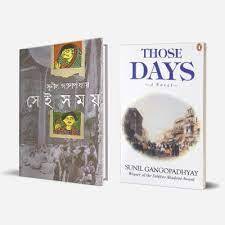Those Days
' Those Days' is the English translation to the masterpiece on 'Bengali Renaissance', known as 'Sei Somoy' written by Sunil Gangopadhyay. The mid-1800s was the time when the British rule strengthened in India and Calcutta was the epicentre. But this was the time when the western language and culture threatened to influence and change the common man, that the Bengali community decided to enrich their roots. This was the foundation of the period known as 'Bengali Renaissance' and this book highlights the lives of those who strived to bring about a change to the language, literature, customs and tradition.
I have read about Raja Rammohan Roy as the man who helped abolish sati, Ishwar Chandra Vidyasagar as the pioneer of widow remarriage and Michael Madhusudan Datta's refinement of the then colloquial language to a language enriched in literature. But I never imagined their lives and struggles before creating history. Rather than portraying them as God, the author has done a brilliant job in showcasing them as human beings, with ups and downs but with a dream for change and progress.
The story begins with the birth of Nabin Kumar Singha (who bears a stark resemblance to Kaliprasanna Singha) the scion of the Singha family. It progresses to show the narrow mindset of the society. Education was only for the sons of rich and well-respected households. Sons from poor families or lower castes were not given the privilege to learn the ancient Sanskrit texts. Girls were married off even before they could walk and if their aged husband died, they were sent to a life of pain and penance of being a widow. Indigo planters were torturing the peasants and ignorance was at its peak.
The story moves on to show the struggles faced by Ishwar Chandra to convince families to get their young widowed daughters remarried, the creative genius with a drinking problem Michael Madhusudan Datta and the efforts made by Nabin Kumar in translating the Mahabharat to Bengali for the masses to benefit from it.
The book is very addicting and leaves you wanting more. I for one wanted to learn more about Ganganarayan Singha, the first man from a rich, well-established family to marry a widow, Kusum Kumari. At parts, I felt the story was too abrupt but I suppose its because I read the translated work. I would recommend this book as a must-read especially if you are into historical fiction.




Comments
Post a Comment